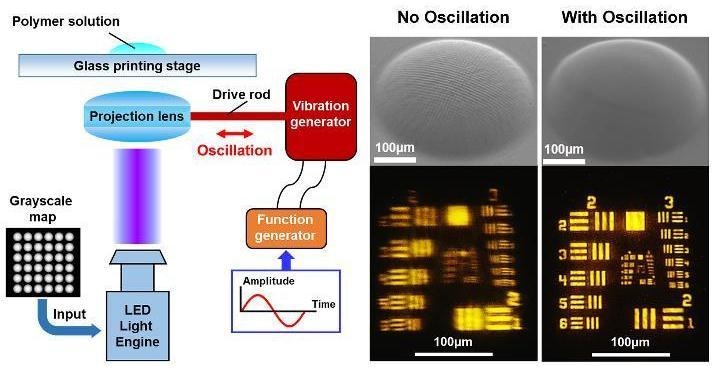Oct 16 2019
Microlens arrays are gaining a significant amount of attention due to the growing demand for miniaturization of optoelectronics. Microlens arrays have become a crucial micro-optics device extensively used in compact imaging, optical communication, sensing, and many others.
 Optically smooth microlens array is fabricated by an oscillation assisted 3D printing method. Owing to the mechanical oscillation applied on the projection lens, jagged surface induced by the gaps between discrete pixels is successfully eliminated to render a low surface roughness of 1 nm, which endows the printed microlenses with high resolving power. (Image credit: SUTD & SUSTech)
Optically smooth microlens array is fabricated by an oscillation assisted 3D printing method. Owing to the mechanical oscillation applied on the projection lens, jagged surface induced by the gaps between discrete pixels is successfully eliminated to render a low surface roughness of 1 nm, which endows the printed microlenses with high resolving power. (Image credit: SUTD & SUSTech)
Usually, the microlens arrays comprise several micron-sized lenses possessing greater uniformity and optical surface smoothness, which increases the need for machining accuracy.
Regardless of the remarkable progress made in manufacturing methods during recent decades, certain restrictions, such as high process complexity, insufficient fabrication flexibility, high time consumption, and difficulty in consistency control for the current methods, still persist.
At present, a team of scientists from the Singapore University of Technology and Design (SUTD) and Southern University of Science and Technology (SUSTech) in Shenzhen, China have suggested a method to combine oscillation-assisted digital light processing (DLP) 3D printing with grayscale UV exposure in order to achieve very fast and flexible fabrication of microlens arrays possessing optical surface smoothness.
3D printing of small geometries with optical surface smoothness is a big challenge. In our approach, the computationally designed grayscale patterns are employed to realize microlens profiles upon one single UV exposure which removes the staircase effect existing in the traditional layer-by-layer 3D printing method, and the projection lens oscillation is applied to further eliminate the jagged surface formed due to the gaps between discrete pixels.
Qi Ge, Project Leader and Associate Professor, SUSTech
Complete morphology characterizations, including atomic force microscopy (AFM) and scanning electron microscopy (SEM) establish that the addition of projection lens oscillation significantly smooths the lens surface and decreases the surface roughness from 200 nm to about 1 nm.
"In addition to surface roughness, lens profile also plays a key role in optical performance." said Chao Yuan, the paper’s co-first author and a postdoctoral research fellow from SUTD. "In order to better assist the grayscale design for microlens array fabrication, we developed a theoretical model to describe the photopolymerization process and predict the lens profile."
The DLP based 3D printing affords remarkable flexibility to the fabrication of microlens arrays. Microlenses with different sizes, geometries and profiles are printable upon one single UV exposure with different grayscale patterns.
Kavin Kowsari, Study Co-First Author and Postdoctoral Research Fellow, SUTD
"Relative to the other fabrication method, our oscillation assisted DLP based printing method is energy- and time-efficient without degradation of optical performance, which is convenient for commercialization and deployment into mass production." said Professor Ge, "Also, this approach provides instructive inspirations for other manufacturing fields with high demands for ultra-smooth surfaces."
This collaborative research was financially supported by SUTD's Digital Manufacturing and Design (DManD) Centre which is backed by the Singapore National Research Foundation (NRF). The research paper has been published in ACS Applied Materials & Interfaces.